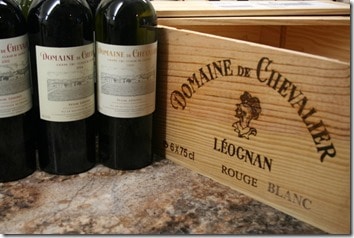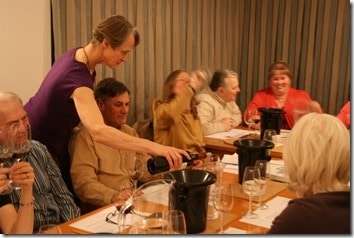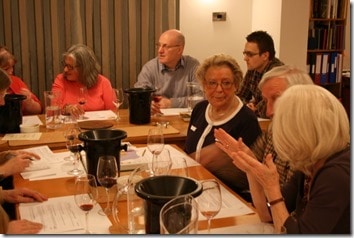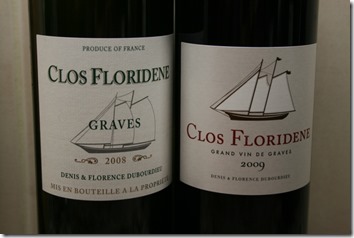 Claret is for collectors. It is quite rare to be able to buy and compare wines from a top estate that are ready to drink and which allow you to compare across vintages. The Wine Society’s recent offer of a small mixed case of Domaine de Chevalier offered just that. It made the perfect basis for a fine wine supper.
Claret is for collectors. It is quite rare to be able to buy and compare wines from a top estate that are ready to drink and which allow you to compare across vintages. The Wine Society’s recent offer of a small mixed case of Domaine de Chevalier offered just that. It made the perfect basis for a fine wine supper.
After the excitement of opening the proper old-fashioned wooden case – there was the planning to make the best of the opportunity. Champagne Laherte Frères Brut Tradition put us all in a good mood – fine bubbles, some floral, biscuit and savoury notes, exceptional palate (lemon, sage, toast) at this comparatively modest price level and good length. As Michael Edwards says (Finest Wines of Champagne): an entry-level Champagne of which you will never tire.
With 14 tasters and just six bottles of Chevalier, we clearly needed some reinforcements and this was admirably supplied by a white and a red from Clos Floridene. This is also a Graves property; in fact, there is a connection between the two. Denis Dubourdieu, owner of Floridene, professor in Bordeaux and influential enologist (one of his contributions is a period of skin contact for white wines to improve the texture of whites was his idea) is the wine consultant to Chevalier. These additional wines meant that we had a good group of whites and reds of various recent vintages.
The whites
White Bordeaux is a pretty unfashionable wine. Reserved, more about texture and balance than overt fruit, it sails under the radar of most wine lovers today, having perhaps been over-exposed in an earlier generation. After all it is white Bordeaux, so it must be good. Clos Floridène AC Graves Blanc 2008 is an exemplary modern white made to quite a traditional recipe. Only 57% Sauvignon means that there is a big role for the 41% Sémillon and perhaps even the 2% Muscadelle. After a short period of skin contact (of course), the wine is fermented in oak barrels, a quarter of which are new and then spends eight months on the lees in barrels which means it can be regularly stirred. All this results in a wine which is smooth and textured in the mouth, with some grippiness, and an overlay of classy oak. It noticeably opened up in the glass from a quiet start. Given a few more years the waxiness of mature Sémillon can be expected to emerge.
Our two Chevalier white wines were the second wine, L’Esprit de Chevalier Blanc, 2007, and a fully mature grand vin from 1999. The former is made from the fruit of the younger vines which here are in a more contemporary blend of predominantly Sauvignon Blanc (70%) and Sémillon. In the glass, this is quite traditional and muted on the nose with fresh fruit accompanied by hints of honey and vanilla. The palate showed refreshing intensity (lemon, grapefruit, peach and smoke) and quite a long finish. The step-up (certainly in price) to the Domaine de Chevalier Blanc 1999 was something of a subtle elevation. Mid gold in colour, the nose combines rounded-out oak, reserved fruit and floral themes before a much more intense palate. Here there was a real hit of intense and complex fruit (ripe apple, melon, angelica). Above all, the wine was remarkably youthful – the freshness promised several more decades of development. It is surprising to be writing about the potential of a thirteen-year-old white wine.
The reds
 The reds offered the same starting point, a young wine from Clos Floridène and then a short vertical from Chevalier. Clos Floridène, AC Graves Rouge, 2009 was a textbook young wine: complex lively nose of graphite, blackcurrant and vanilla; medium-weight palate, quite intense fruit, a substantial vein of acidity and youthful, medium-grained tannins and decent length. This adds up to benchmark, youthful Claret from a very fruit-forward vintage, made from 65% Cabernet Sauvignon and 35% Merlot which has 20-25 days on the skins and 12 months in barriques, one-third new. Even for non-Bordeaufiles, when the vintage and the winemaking is as good as this, young red Bordeaux makes for good drinking.
The reds offered the same starting point, a young wine from Clos Floridène and then a short vertical from Chevalier. Clos Floridène, AC Graves Rouge, 2009 was a textbook young wine: complex lively nose of graphite, blackcurrant and vanilla; medium-weight palate, quite intense fruit, a substantial vein of acidity and youthful, medium-grained tannins and decent length. This adds up to benchmark, youthful Claret from a very fruit-forward vintage, made from 65% Cabernet Sauvignon and 35% Merlot which has 20-25 days on the skins and 12 months in barriques, one-third new. Even for non-Bordeaufiles, when the vintage and the winemaking is as good as this, young red Bordeaux makes for good drinking.
The Domaine de Chevalier wines are best dealt with in two pairs. First up we have two wines from the quite classic 2004 vintage. Temperatures in summer were around the average with August being wet and cool but being compensated for by sunshine and high temperatures in September.* L’Esprit de Chevalier is again the wine from the young vines, in this case, 65% Cabernet Sauvignon, 30% Merlot and 2.5% each Cabernet Franc and Petit Verdot, planted at 10,000 vines per hectare – dense planting in a moderate climate reduces yields and potentially raises fruit quality. There was a noticeable jump up in quality here with greater fruit concentration and spiciness on the nose and palate. Quite prominent tannins meant this is really still a wine to drink with food but overall the wine was youthful and impressive. By contrast, the Domaine de Chevalier Rouge from the same year was not really ready to drink or, at least, not at its peak. The potential was clear enough: dense blackberry and blackcurrant fruit, excellent concentration and a velvety texture, the ‘nerve of acidity’ and a fine tannic structure. As a ‘young wine’ it was outstanding but probably most are going to buy this wine to drink it at its peak from two to three years time onwards when it also shows some tertiary complexity.
 Our final pair showed what all the fuss is about when it comes to red Bordeaux. These were Domaine de Chevalier Rouge 2002 and 2000. The younger of these two wines was on the doorstep of maturity. It comes from another quite mixed year with a cool July and August (poor holidaymakers) and a fine early autumn producing wines of above-average acidity with the Cabernet doing best of all the varieties as it ripens late. At eleven years old the fruit and acidity are finely balanced with the fruit aromas now being joined by beguiling cedar and coffee notes. The fruit was still to the fore but the wine has spent long enough time in the bottle to integrate the elements which were there and to develop some complexity from age. This was definitively the case for the 2000 at thirteen years of age. It also benefitted from an excellent year, with warm dry conditions from mid-July to mid-September, a small amount of refreshing rain and then perfect dry picking conditions. In the glass now the fragrance of the cigar box meets the red and black fruit of the market stall with a near-perfect integration of the two; fine-textured long tannins; overall the wine was subtle, elegant, complex and long.
Our final pair showed what all the fuss is about when it comes to red Bordeaux. These were Domaine de Chevalier Rouge 2002 and 2000. The younger of these two wines was on the doorstep of maturity. It comes from another quite mixed year with a cool July and August (poor holidaymakers) and a fine early autumn producing wines of above-average acidity with the Cabernet doing best of all the varieties as it ripens late. At eleven years old the fruit and acidity are finely balanced with the fruit aromas now being joined by beguiling cedar and coffee notes. The fruit was still to the fore but the wine has spent long enough time in the bottle to integrate the elements which were there and to develop some complexity from age. This was definitively the case for the 2000 at thirteen years of age. It also benefitted from an excellent year, with warm dry conditions from mid-July to mid-September, a small amount of refreshing rain and then perfect dry picking conditions. In the glass now the fragrance of the cigar box meets the red and black fruit of the market stall with a near-perfect integration of the two; fine-textured long tannins; overall the wine was subtle, elegant, complex and long.
The evening was rounded off with a tasty pheasant, duck and prune casserole and a stupendous frangipane tart, with old, moderate quality, Sauternes (and LBV Port (Grahams 1988 on the downward slope) … All in all, this was an excellent evening of fine wines, the chance to compare them side by side and learn from them, good food and company.
One final reflection: these wines impressed me with their quality but how much did I enjoy them? Top-quality red Bordeaux is not just for the collector but also for the patient – the red Chevalier needs to be well into its second decade to show its best. At less expensive price levels, red Bordeaux is rarely as exciting as the 2009 vintage. On the white front, the Clos Floridène is exemplary at the price but the Chevalier overly reserved. The 1999, for me, did not show the development I would hope for in a 13-year-old bottle – and is it really going to improve markedly thereafter? I continue to struggle (to enjoy) Bordeaux except at the very top levels – which I can’t really afford. Fortunately, there is a whole world of wine out there to be explored and enjoyed.
* Domaine de Chevalier is to be congratulated for putting objective and detailed descriptions of the weather conditions for each year in French and English on its website. These summaries of the weather conditions are drawn up by academics from the Bordeaux Faculty of Oenology.
Return to France homepage



Comments are closed.